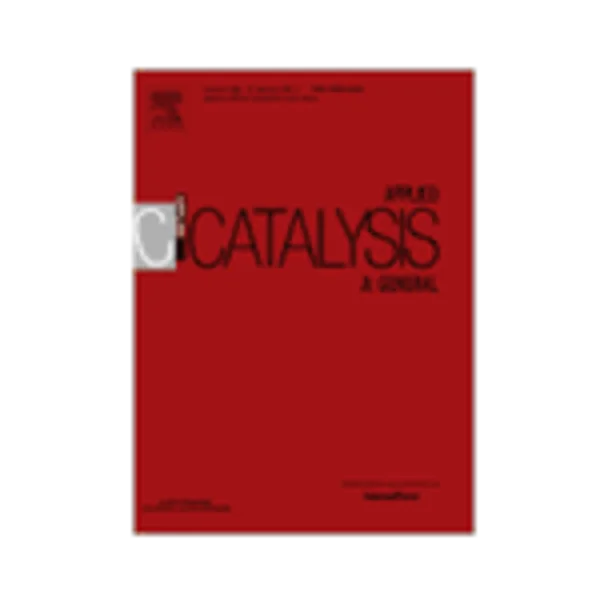-
ni–fe catalysts derived from hydrotalcite-like precursors for hydrogen production by ethanol steam reforming
جزئیات بیشتر مقاله- تاریخ ارائه: 1392/07/24
- تاریخ انتشار در تی پی بین: 1392/07/24
- تعداد بازدید: 1072
- تعداد پرسش و پاسخ ها: 0
- شماره تماس دبیرخانه رویداد: -
nickel–iron mixed oxides derived from reevesite, a hydrotalcite-type compound, were tested in steam reforming of ethanol for hydrogen production. the influence of iron content (ni/fe ranging from 3 to 1) and the calcination temperature of the catalyst precursor (773 and 1073 k) on the catalytic performance were investigated. both parameters were essential to optimize the reforming performance. increasing the amount of iron in the reevesite precursors affected both the chemical and activity properties of the derived mixed oxide catalysts. iron displays a positive role in nickel-based catalysts due to the enhancement of catalytic activity and hydrogen selectivity induced by the improved dispersion of nickel and the alleviation in carbon deposition. the calcination temperature led to variations in phase composition consisting of ni(fe)ox solid solution and nife2o4, which affected the final size and dispersion of nickel species formed during the reaction. the best catalyst, with a ni/fe ratio of 1 and calcined at 773 k, rendered high and stable hydrogen and carbon dioxide selectivity of up to ca. 60% and 40%, respectively, low methane content, and consisted of a ni(fe)ox + nife2o4 mixture with high surface area and small ni0 crystallites. a higher percentage of crystalline nife2o4 attained at high calcination temperature (1073 k) associated with a lower carbon deposition resistance and probably ni0 sintering brings about lower activity and fast deactivation. the improved performance over catalysts calcined at lower temperature and with lower ni/fe ratio is motivated by the effect of iron on the structural and electronic properties of the mixed oxides, thus inducing a slow formation of metallic nickel particles and coke deposits. features like high surface area, higher iron content, lower reducibility of nickel species and small nickel crystallite size well dispersed on the surface of the catalyst with high iron content lead to a higher activity in ethanol dehydrogenation, acetaldehyde decarbonylation and reforming, and wgs.
مقالات جدیدترین رویدادها
-
استفاده از تحلیل اهمیت-عملکرد در ارائه الگوی مدیریت خلاقیت سازمانی و ارائه راهکار جهت بهبود
-
بررسی تاثیر ارزش وجوه نقد مازاد بر ساختار سرمایه شرکت های پذیرفته شده در بورس اوراق بهادار تهران
-
بررسی تأثیر سطح افشای ریسک بر قرارداد بدهی شرکت های پذیرفته شده در بورس اوراق بهادار تهران
-
بررسی تأثیر رتبه بندی اعتباری مبتنی بر مدل امتیاز بازار نوظهور بر نقد شوندگی سهام با تأکید بر خصوصی سازی شرکت ها
-
تأثیر آمیخته بازاریابی پوشاک ایرانی بر تصویر ذهنی مشتری پوشاک ایرانی (هاکوپیان)
-
تأثیر خطای ساخت تیر پیوند میانی در رفتار اتصالات خمشی ستون درختی فولادی
-
مقایسه انواع طلاق در فقه امامیه و اهل تسنن
-
بررسی رابطه بین جامعه پذیری کارکنان و رفتار شهروندی سازمانی با نقش میانجی مسئولیت اجتماعی کارکنان (مورد مطالعه: شهرداری زاهدان)
-
مدل سازی فرایند شیرین سازی گاز های ترش کم فشار به روش تبدیل کاتالیستی h2s به متیل مرکاپتان
-
interval estimation for a general class of exponential distributions under progressive censoring
مقالات جدیدترین ژورنال ها
-
مدیریت و بررسی افسردگی دانش آموزان دختر مقطع متوسطه دوم در دروان کرونا در شهرستان دزفول
-
مدیریت و بررسی خرد سیاسی در اندیشه ی فردوسی در ادب ایران
-
واکاوی و مدیریت توصیفی قلمدان(جاکلیدی)ضریح در موزه آستان قدس رضوی
-
بررسی تاثیر خلاقیت، دانش و انگیزه کارکنان بر پیشنهادات نوآورانه کارکنان ( مورد مطالعه: هتل های 3 و 4 ستاره استان کرمان)
-
بررسی تاثیر کیفیت سیستم های اطلاعاتی بر تصمیم گیری موفق در شرکتهای تولیدی استان اصفهان (مورد مطالعه: مدیران شرکتهای تولیدی استان اصفهان)
-
بررسی تاثیر هویت برند بر ارزیابی برند و ایجاد وفاداری مشتریان
-
پیش بینی تعهد زناشویی براساس باورهای ارتباطی و طرحواره های ناسازگار اولیه با میانجی گری الگوهای ارتباطی زوجین ورضایت جنسی و سبک های حل تعارض
-
ارتباط توانمندسازی روانشناختی با تمایل اعضای هیئت علمی به برنامه های بالندگی با نقش میانجی انگیزش درونی
-
برنامه ریزی استراتژیک توسعه گردشگری در منطقه نمونه گردشگری انشان در استان خوزستان
-
effect of hybrid fibers on water absorption and mechanical strengths of geopolymer concrete based on blast furnace slag




سوال خود را در مورد این مقاله مطرح نمایید :